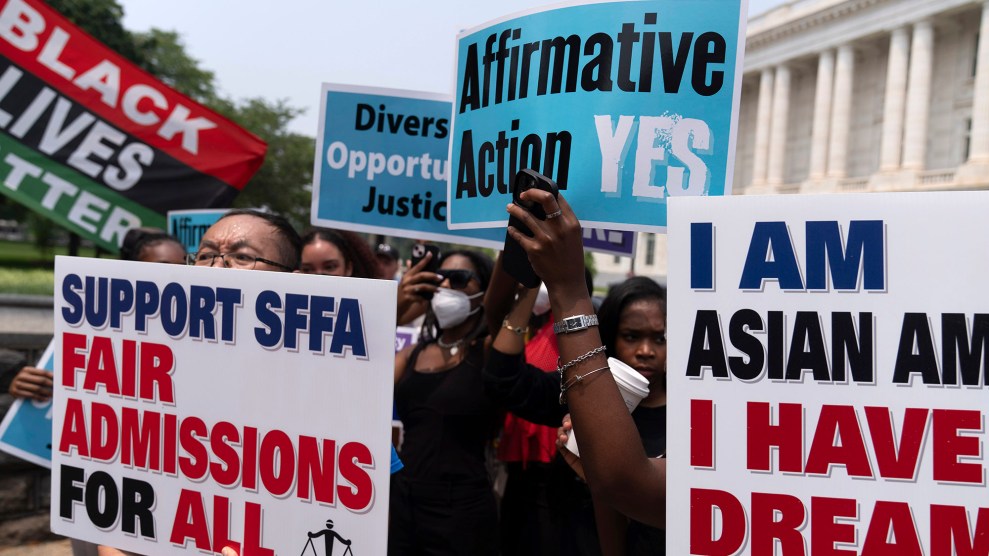Even before the polar bear received “threatened” status under the Endangered Species Act in May, a host of organizations were already laying the groundwork for a legal challenge. As early as last January, Jim Sims, the president and CEO of the Western Business Roundtable, which reps for oil and mining interests, sent an email to colleagues detailing a strategy to “quite possibly reverse” the ruling, if the worst came to pass. Part of it would involve litigation filed by a “truly extraordinary plaintiff”: Roy Innis, the chairman of the Congress of Racial Equality (CORE), a decades-old civil rights group that has taken a sharp turn to the right under his leadership, joining forces with conservative activists particularly on issues related to the environment.
It looks like the plan is finally in motion. On Wednesday, the Pacific Legal Foundation, a conservative legal advocacy group that is representing CORE, the California Cattleman’s Association, and the California Forestry Association, has sent what’s known as a “60-Day Notice” (which is required before formally filing suit in this case) to Dale Hall, director of the Fish and Wildlife Service, and Interior Secretary Dirk Kempthorne. “You are advised immediately to withdraw the Final Rule as unlawful and unwarranted,” the letter states. “Failure to do so will result in legal action to invalidate the final rule.”
As expected, their legal strategy will seek to challenge the science underpinning Interior’s determination, which shows that climate change is rapidly eroding the sea ice that serves as the polar bears’ primary habitat. Among other things, the PLF contends:
The “prediction” that 2/3 of the polar bear population will be lost by mid-century, touted by the popular press, is incorrect. That estimate is the guesswork of one man and is based on a qualitative “prototype” model that the Department warns is only preliminary and not to be taken as final.
And:
As temperatures have increased over the past 40-50 years, the polar bear population has increased to the highest levels in recorded history. The current population is approximately 25,000, up from an estimated low of 5,000-10,000 in the 50’s and 60’s.
As for the first claim, the “one man” in question also happens to be one of world’s foremost authorities on polar bears, Dr. Steven Amstrup, whose “guesswork” was contained in a study conducted by the US Geological Survey, where Amstrup works as a wildlife biologist. As for the second contention (that polar bears are actually thriving), that seems clearly at odds with the reality on the ground. In May, when I spoke to leading polar bear ecologist Andrew Derocher, who was studying the bears in the Arctic at the time, he said: “It’s looking to be one of the worst years I’ve seen up here in a long time. It’s probably an extension of the low ice year we saw last year in the Beaufort Sea, actually throughout the Arctic. We haven’t done anywhere near what we’d normally do. We’re just not seeing many bears here. I know from talking on email with Alaskan colleagues they’re seeing something very similar this year as well.” He also told me: “Any notion that the population has increased in a large scale sort of context is highly unlikely, highly unsupported by any scientific data… We don’t know how many bears there were before. We have very little census data on most areas in the Arctic. We have no idea how many bears there were in the 1960s. Absolutely zero. Some people have said that in the 1960s there were 5,000. Nobody knows.”
The Pacific Legal Foundation’s letter goes on to say that “researchers from Wharton and Harvard have found that none of the models”—forecasting a rapidly declining polar bear population—”meets accepted scientific standards.” The researchers the PLF is referring to are J. Scott Armstrong and Willie Soon. Armstrong, for his part, is not a scientist but a professor of marketing at Wharton and an expert on forecasting methods. (He has previously blasted the forecasting approach used by the Intergovernmental Panel on Climate Change). Soon is an astrophysicist at the Harvard-Smithsonian Center for Astrophysics and a darling of the global warming denial crowd. And there’s just one more thing about Willie Soon: His work has been funded by the oil industry, which most definitely has a dog in the global warming and polar bear fights. In a 2007 study (published as a “viewpont” since it didn’t pass muster under peer review) that Soon co-authored, disputing the climate change explanation for the polar bears’ habitat loss, the researcher acknowleged that his work was “partially supported by grants from the…American Petroleum Institute, and Exxon-Mobil Corporation.”
Aside from challenging global warming science, the PLF also intends to make the argument, one advanced by Innis’ group, that listing the bear could wind up disproportionately affecting poor people and minorities. Presumably this would occur through higher energy costs due to closing down oil rich areas, including the Arctic National Wildlife Refuge, to drilling. (Though this is something the Interior Department has emphatically said the listing won’t do—a claim that is the subject of a lawsuit brought by conservation groups.)
Back in May, the Western Business Roundtable’s Jim Sims told me, “You’re going to start seeing lawsuits like dandelions in a field the day after the regulations are filed.” It looks like the first crop are starting to sprout up.
Photo by flickr user longhorndave used under a Creative Commons license.














